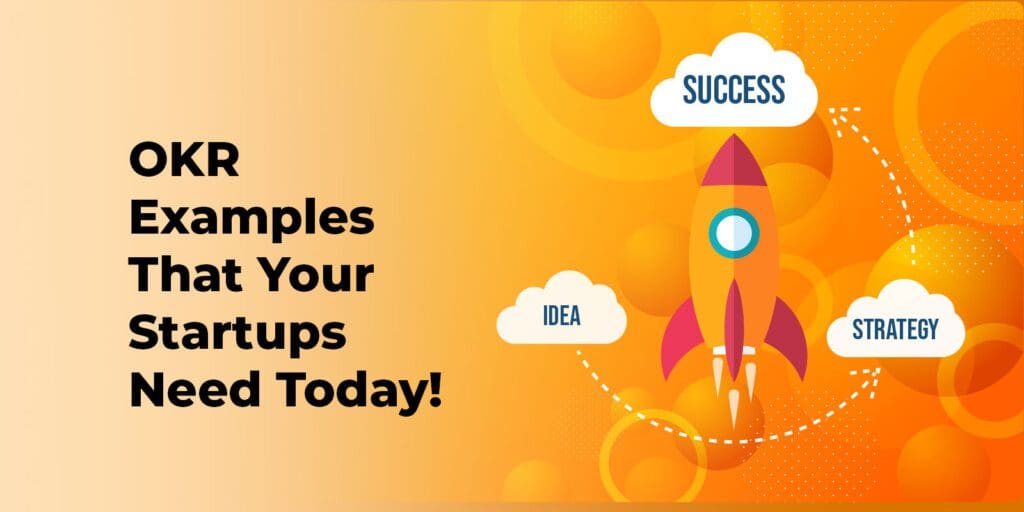Table of Contents
OKR Examples That Your Startups Need Today!
The term ‘startup’ refers to a company at its novice or beginner stages of operation. It is like a flightless bird just trying to take off, and hence requires the right resources, investors, and employees to succeed. Startups are established by one or more entrepreneurs who wish to develop a product or service that is in demand.
They might choose to fully quit their existing day jobs to work on their startup or simultaneously develop it until it is successful. Startups also generally start with high costs and demands and limited revenue and resource, which is usually why venture capitalists take interest in investing in them.
Hence, startups are one of the many departments that can highly benefit from setting proper objectives and key results. They can track their progress and make necessary revisions through the OKR framework, which stands for Objectives and Key Results. In this blog, let’s take a look at how startups can set OKRs for successfully achieving their goals.
How to Build a Successful Startup With the OKR framework
Most of the realistic plans involved in building a startup will require time, dedication, commitment, and a good investment source. Starting one’s own business is a difficult and brave decision; however, with consistency and proper steps and goals undertaken, the odds of failing are greatly reduced. Some crucial steps to keep in mind include:
- Committing to a plan
- Starting with the right plan built on a solid foundation
- Networking with the right groups
- Setting the right goals and objectives and achieving them in a time-bound manner
This is where the OKR methodology becomes quintessential. The beginning months can be quite chaotic as the founders will have to juggle everything from scrum calls to major investment meetings. A goal-setting framework like OKRs will bring focus, transparency and commitment to goals. Through this, companies in their early stages can prioritise their focus and foster creativity among team members who will be working on projects together to achieve their goals.
Key points to Remember when Setting OKRs for Startups
It is important to create OKRs that consider the resources, number of employees, and other factors at the disposal of a startup. Since they are at the beginner level, approaching OKRs with this mindset will come in handy.
Objective: This explains what are the goals the company wants to achieve within the next quarter.
Key Results: Ranging from 1-5, these outline how the company will measure the progress towards the said objective.
OKR Examples for Startups
1. Objective
Grow company revenue within the South Asian region
Key Result 1
Increase demo outreach from 10 to 90
Key Result 2
Conduct data analysis on customer purchases from at least 10 countries
Key Result 3
Increase the number of channel partners from 10 to 40
2. Objective
Attain long-term growth in the sales department
Key Result 1
Increase revenue by 30% within the next 2 years
Key Result 2
Venture out into at least 4 new geographic regions
Key Result 3
Achieve a net promoter score (NPS) of 8 or higher
3. Objective
Improve product market fit
Key Result 1
Understand customer needs through 3 customised customer satisfaction surveys
Key Result 2
Increase customer engagement with the product by 30%
Key Result 3
Achieve 4.0 or higher customer ratings on the official product website
4. Objective
Increase brand awareness and customer acquisition
Key Result 1
Promote the brand through at least 3 social media influencers.
Key Result 2
Increase website traffic by 20%
Key Result 3
Launch new products based on customer suggestion
5. Objective
Increase conversion rates
Key Result 1
Launch targeted market campaigns and increase conversion rates by 5%
Key Result 2
Convert at least 10 visitors into subscribed customers
Key Result 3
Implement A/B testing on landing pages
6. Objective
Cultivate a positive company culture and improve employee engagement
Key Result 1
Hold diversity meetings once a quarter to become more inclusive
Key Result 2
Increase employee retention rate by 40%
Key Result 3
Ensure at least 2 team projects per month to foster employee satisfaction and interaction


7. Objective
Increase social media engagement on both Twitter and Instagram
Key Result 1
Increase overall social media followers by at least 15%
Key Result 2
Conduct 3 live streams per quarter to engage with potential customers
Key Result 3
Increase web traffic by 20% through a social media campaign
8. Objective
Become the ‘go-to’ company for ‘X’ service
Key Result 1
Increase Weekly Active Users rate from 8% to 20%
Key Result 2
Provide 1 free trial for all new users
Key Result 3
Convert 300 free trial members to paid members by the end of the quarter
Hence, startups should always ensure to maintain their focus on the Retention and Activation stages of the AARRR funnel (in that order). AARRR stands for Acquisition, Activation, Retention, Referral, Revenue.
9. Objective
Set the track to achieve a seed round
Key Result 1
Reach Annual Recurring Revenue (ARR) of $100k
Key Result 2
Branch out into 3 funding sources
Key Result 3
Achieve a 30% year-on-year growth in revenue
10. Objective
Enhance product innovation
Key Result 1
Consult with the product team and launch 2 new products by the end of the quarter
Key Result 2
Receive 400 customer feedback and apply their inputs through the product development team
Key Result 3
Conduct a creativity session once a month to brainstorm product ideas
Thus, using OKRs for startups is especially useful since it helps to balance tasks and align the employees with company goals. With the aid of OKR software such as 10xOKR, your startup can also thrive and receive the help it needs! OKR templates can help guarantee that objectives are clearly outlined along with measurable key results.
Sign up for free today and access the benefits of better tracking and analysis of your company’s progress.



